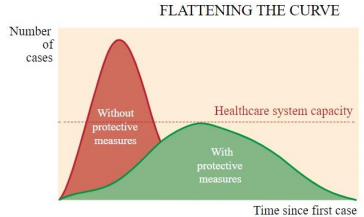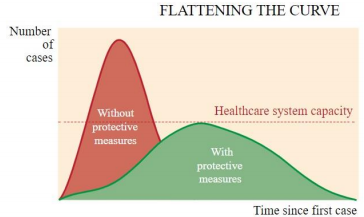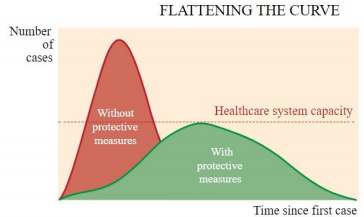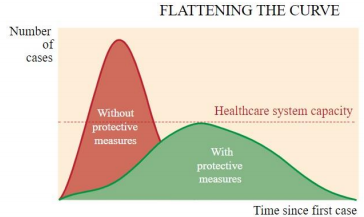Questões de Inglês do ano 2020
Lista completa de Questões de Inglês do ano 2020 para resolução totalmente grátis. Selecione os assuntos no filtro de questões e comece a resolver exercícios.
Read the text bellow in order to answer the question:
Coronavirus, Social Distancing and Self-Quarantine
Now that the new coronavirus and COVID-19, the illness it causes, are spreading among communities in the United States and other countries, phrases such as social distancing, self-quarantine and flattening the curve are showing up in the media.
What is flattening the curve?
Flattening the curve refers to using protective practices to slow the rate of COVID-19 infection so hospitals have room, supplies and doctors for all of the patients who need care.

A large number of people becoming very sick over the course of a few days could overwhelm a hospital or care facility. Too many people becoming severely ill with COVID-19 at roughly the same time could result in a shortage of hospital beds, equipment or doctors.
On a graph, a sudden surge in patients over a short time could be represented as a tall, narrow curve.
On the other hand, if that same large number of patients arrived at the hospital at a slower rate, for example, over the course of several weeks, the line of the graph would look like a longer, flatter curve.
In this situation, fewer patients would arrive at the hospital each day. There would be a better chance of the hospital being able to keep up with adequate supplies, beds and health care providers to care for them.
https://www.hopkinsmedicine.org/health/conditions-and-diseases/coronavirus/coronavirus-social-distancing-and-self-quarantine
Analyze the following statements regarding to the text from question :
I- The words causes, refers and slow, in the text, are classified as verbs. II- In the first paragraph, the letter i in the word quarantine is pronounced differently compared to any letter i in the word distancing. III- The words could and would are examples of modal verbs used in the text. IV- In the text, the words very, severely and roughly are classified as adverbs.
Choose the alternative with the correct answer:
I- The words causes, refers and slow, in the text, are classified as verbs. II- In the first paragraph, the letter i in the word quarantine is pronounced differently compared to any letter i in the word distancing. III- The words could and would are examples of modal verbs used in the text. IV- In the text, the words very, severely and roughly are classified as adverbs.
Choose the alternative with the correct answer:
-
A) Only statement I and II are correct.
B) Only statements I and IV are correct.
C) Only statement III is correct.
D) All the statements are correct.
E) Only statements III and IV are correct.
Read the text bellow in order to answer the question:
Coronavirus, Social Distancing and Self-Quarantine
Now that the new coronavirus and COVID-19, the illness it causes, are spreading among communities in the United States and other countries, phrases such as social distancing, self-quarantine and flattening the curve are showing up in the media.
What is flattening the curve?
Flattening the curve refers to using protective practices to slow the rate of COVID-19 infection so hospitals have room, supplies and doctors for all of the patients who need care.

A large number of people becoming very sick over the course of a few days could overwhelm a hospital or care facility. Too many people becoming severely ill with COVID-19 at roughly the same time could result in a shortage of hospital beds, equipment or doctors.
On a graph, a sudden surge in patients over a short time could be represented as a tall, narrow curve.
On the other hand, if that same large number of patients arrived at the hospital at a slower rate, for example, over the course of several weeks, the line of the graph would look like a longer, flatter curve.
In this situation, fewer patients would arrive at the hospital each day. There would be a better chance of the hospital being able to keep up with adequate supplies, beds and health care providers to care for them.
https://www.hopkinsmedicine.org/health/conditions-and-diseases/coronavirus/coronavirus-social-distancing-and-self-quarantine
Observe the vocabulary selected from the text from question in the first column and the definitions in the second column. Match the columns relating vocabulary to its definition:
First Column: Vocabulary 1- illness 2- overwhelm 3- shortage 4- narrow 5- facility
Second Column: Definition/Synonym ( ) of small width. ( ) to have an excessive load or amount. ( ) space or equipment necessary for doing something. ( ) the lack of something in sufficient amounts. ( ) the condition of not having good health.
Choose the alternative that presents the correct match:
First Column: Vocabulary 1- illness 2- overwhelm 3- shortage 4- narrow 5- facility
Second Column: Definition/Synonym ( ) of small width. ( ) to have an excessive load or amount. ( ) space or equipment necessary for doing something. ( ) the lack of something in sufficient amounts. ( ) the condition of not having good health.
Choose the alternative that presents the correct match:
-
A) 4 2 3 5 1.
B) 4 2 3 1 5.
C) 5 1 3 4 2.
D) 4 2 5 3 1.
E) 5 4 2 1 3.
Read the text bellow in order to answer the question:
Coronavirus, Social Distancing and Self-Quarantine
Now that the new coronavirus and COVID-19, the illness it causes, are spreading among communities in the United States and other countries, phrases such as social distancing, self-quarantine and flattening the curve are showing up in the media.
What is flattening the curve?
Flattening the curve refers to using protective practices to slow the rate of COVID-19 infection so hospitals have room, supplies and doctors for all of the patients who need care.

A large number of people becoming very sick over the course of a few days could overwhelm a hospital or care facility. Too many people becoming severely ill with COVID-19 at roughly the same time could result in a shortage of hospital beds, equipment or doctors.
On a graph, a sudden surge in patients over a short time could be represented as a tall, narrow curve.
On the other hand, if that same large number of patients arrived at the hospital at a slower rate, for example, over the course of several weeks, the line of the graph would look like a longer, flatter curve.
In this situation, fewer patients would arrive at the hospital each day. There would be a better chance of the hospital being able to keep up with adequate supplies, beds and health care providers to care for them.
https://www.hopkinsmedicine.org/health/conditions-and-diseases/coronavirus/coronavirus-social-distancing-and-self-quarantine
Regarding the interpretation of the text above, choose the correct alternative:
-
A) The author believes that flattening the curve is the key to soften the final results of the situation.
B) For the author, flattening the curve is the same as washing hands every three hours and roughening the curve is the same as staying home.
C) The author believes that roughening the curve is the key to soften the final results of the situation.
D) According to the author, a sudden surge in patients over a short time means flattening the curve.
E) The author thinks that fewer patients would arrive at the hospital each day if people went back to their jobs as usual.
Read and analyze the following statements:
I- According to ECA (Statute of Children and Adolescent) It is the duty of the public authorities only, to ensure, with absolute priority, the effective rights relating to life, health, food, education, sport, leisure, professionalization, culture, dignity, respect, freedom and family and community coexistence. II- The completion of the latest version of the BNCC determines the obligation to teach English language starting in the first grade of elementary school. III- According to the BNCC, teaching English means reviewing the relationships between language, territory and culture, as English speakers are no longer found only in countries where this is the official language. IV- The BNCC understands the learning of English in a perspective of an education that is linguistic, conscious and critical, in which the pedagogical and political dimensions are intrinsically linked.
Choose the alternative with the correct answer:
I- According to ECA (Statute of Children and Adolescent) It is the duty of the public authorities only, to ensure, with absolute priority, the effective rights relating to life, health, food, education, sport, leisure, professionalization, culture, dignity, respect, freedom and family and community coexistence. II- The completion of the latest version of the BNCC determines the obligation to teach English language starting in the first grade of elementary school. III- According to the BNCC, teaching English means reviewing the relationships between language, territory and culture, as English speakers are no longer found only in countries where this is the official language. IV- The BNCC understands the learning of English in a perspective of an education that is linguistic, conscious and critical, in which the pedagogical and political dimensions are intrinsically linked.
Choose the alternative with the correct answer:
-
A) Only statements I and III are correct.
B) Only statements I, III and IV are correct.
C) Only statements III and IV are correct.
D) Only statement IV is correct.
E) All the statements are correct.
In any language, some words can be replaced without changing the complete meaning. Observe the vocabulary in the first column and their possible synonyms in the second column. Match the columns relating vocabulary to its synonym:
First Column: Vocabulary 1- but 2- excellent 3- compliment 4- assume 5- should
Second Column: Synonym ( ) terrific ( ) nevertheless ( ) suppose ( ) praise ( ) ought to
Choose the alternative that presents the correct match:
First Column: Vocabulary 1- but 2- excellent 3- compliment 4- assume 5- should
Second Column: Synonym ( ) terrific ( ) nevertheless ( ) suppose ( ) praise ( ) ought to
Choose the alternative that presents the correct match:
-
A) 2 1 3 4 5.
B) 2 1 4 3 5.
C) 2 5 4 3 1.
D) 5 3 4 1 2.
E) 4 1 2 3 5.
Read these statements about the Base Nacional Comum Curricular (BNCC), then choose the correct alternative:
-
A) In the idea of BNCC, the English language becomes a language of "foreigner", coming from hegemonic countries, unrelated to the rest of the world.
B) The new BNCC proposal considers only linguistic and cultural repertoires from English-speaking countries as a first language.
C) BNCC starts to prioritize the focus of the social and political function of the English language and, in this sense, starts to treat it in its lingua franca status.
D) In the view of BNCC, English teaching in the classroom is that spoken by Americans and British. The English of a person with an accent from a country where English is not spoken would only confuse the learning process.
E) The BNCC foresees the teaching of the English language as the teaching of a second language with the objective of, in the future, making English the co-official language of Brazil.
Read the following statements:
I- The risk is that things may be brewing underneath the surface. II- The Senate approved a bill that promises a $1,200 payout to millions of Americans. III- Crowded camps, depleted clinics and scarce soap and water make social distancing and even hand-washing impossible for millions of refugees. IV- They would just preferred not to discuss it right now. Choose the correct alternative:
I- The risk is that things may be brewing underneath the surface. II- The Senate approved a bill that promises a $1,200 payout to millions of Americans. III- Crowded camps, depleted clinics and scarce soap and water make social distancing and even hand-washing impossible for millions of refugees. IV- They would just preferred not to discuss it right now. Choose the correct alternative:
-
A) Only statements I and II are grammatically correct.
B) Only statements II, III and IV are grammatically correct.
C) Only statement I is grammatically correct.
D) Only statements I, II and III are grammatically correct.
E) All the statements are grammatically correct.
Read the text bellow in order to answer the question:
Coronavirus, Social Distancing and Self-Quarantine
Now that the new coronavirus and COVID-19, the illness it causes, are spreading among communities in the United States and other countries, phrases such as social distancing, self-quarantine and flattening the curve are showing up in the media.
What is flattening the curve?
Flattening the curve refers to using protective practices to slow the rate of COVID-19 infection so hospitals have room, supplies and doctors for all of the patients who need care.

A large number of people becoming very sick over the course of a few days could overwhelm a hospital or care facility. Too many people becoming severely ill with COVID-19 at roughly the same time could result in a shortage of hospital beds, equipment or doctors.
On a graph, a sudden surge in patients over a short time could be represented as a tall, narrow curve.
On the other hand, if that same large number of patients arrived at the hospital at a slower rate, for example, over the course of several weeks, the line of the graph would look like a longer, flatter curve.
In this situation, fewer patients would arrive at the hospital each day. There would be a better chance of the hospital being able to keep up with adequate supplies, beds and health care providers to care for them.
https://www.hopkinsmedicine.org/health/conditions-and-diseases/coronavirus/coronavirus-social-distancing-and-self-quarantine
Read the statements about the text from question and classify them as true (T) or false (F):
( ) The pronoun it in the first paragraph refers to the word illness. ( ) The modal verb would, in the excerpt fewer patients would arrive at the hospital each day, adds the idea of possibility to the sentence. ( ) The expressions showing up, look like and keep up are examples of phrasal verbs used in the text. ( ) If the text was all written using Past Simple Tense, none of the words become, have, cause, refer and show would be written using the suffix ed. ( ) The pronoun them in the last paragraph refers to supplies, beds and health care providers.
Choose the alternative with the correct sequence:
( ) The pronoun it in the first paragraph refers to the word illness. ( ) The modal verb would, in the excerpt fewer patients would arrive at the hospital each day, adds the idea of possibility to the sentence. ( ) The expressions showing up, look like and keep up are examples of phrasal verbs used in the text. ( ) If the text was all written using Past Simple Tense, none of the words become, have, cause, refer and show would be written using the suffix ed. ( ) The pronoun them in the last paragraph refers to supplies, beds and health care providers.
Choose the alternative with the correct sequence:
-
A) T F T F F.
B) F T F F F.
C) F F T T F.
D) T F T F T.
E) F F T F F.
Read the statements about Textual Genres and classify them as true (T) or false (F):
( ) According to Mikhail Bakhtin, textual genres are defined mainly by their social function. ( ) Textual genres are texts that are used for a particular reason in a communicative situation to promote a specific interaction. ( ) As they serve the need to communicate, textual genres are transmuted by presenting new forms from existing ones. The email address, for example, is a variation of the letter's communicative function. ( ) Textual genres define what kind of literature will be read by men and what type will be read by women. ( ) A textual genre is any one of the several linear sequences of elements of some specific kind whose combination constitutes a phonological representation.
Choose the alternative with the correct sequence:
( ) According to Mikhail Bakhtin, textual genres are defined mainly by their social function. ( ) Textual genres are texts that are used for a particular reason in a communicative situation to promote a specific interaction. ( ) As they serve the need to communicate, textual genres are transmuted by presenting new forms from existing ones. The email address, for example, is a variation of the letter's communicative function. ( ) Textual genres define what kind of literature will be read by men and what type will be read by women. ( ) A textual genre is any one of the several linear sequences of elements of some specific kind whose combination constitutes a phonological representation.
Choose the alternative with the correct sequence:
-
A) T T T T T.
B) T T F F T.
C) T T T F F.
D) F T T F T.
E) F F T T F.
Read and analyze the following statements, then choose the correct alternative:
-
A) In the Content and Language Integrated Learning (CLIL), grammar isnt taught explicitly but is learned inductively through repeated exposure to the spoken language. Activities like word-picture association, dialogues and role playing are used so the students can figure out the rules for themselves.
B) In the Content and Language Integrated Learning (CLIL), the end goal is the forming of linguistic speaking habits through correct repetitions.
C) Content and Language Integrated Learning (CLIL) presents the teacher talking as little as possible as something very important. Students need to employ plenty of gestures and facial expressions to communicate with classmates.
D) Content and Language Integrated Learning (CLIL) consists on classes to learn specifically the four abilities: speaking, listening, writing and reading.
E) Content and Language Integrated Learning (CLIL) is described as both learning another content/subject such as physics or geography through the medium of a foreign language and learning a foreign language by studying a content-based subject.


